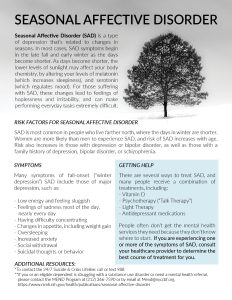December is Seasonal Affective Disorder Awareness Month
December is Seasonal Affective Disorder Awareness Month
December 5, 2022
 WHAT IS SEASONAL AFFECTIVE DISORDER
WHAT IS SEASONAL AFFECTIVE DISORDER
Seasonal Affective Disorder (SAD) is a type of depression that’s related to changes in seasons. In most cases, SAD symptoms begin in the late fall and early winter as the days become shorter. As days become shorter, the lower levels of sunlight may affect your body chemistry, by altering your levels of melatonin (which increases sleepiness), and serotonin (which regulates mood). Seasonal Affective Disorder impacts 10,000,000 Americans every year.
RISK FACTORS
SAD is most common in people who live farther north, where the days in winter are shorter. Women are four times more likely than men to experience SAD, and risk of SAD increases with age. Risk also increases in those with depression or bipolar disorder, as well as those with a family history of depression, bipolar disorder, or schizophrenia.
WHAT ARE SYMPTOMS OF SAD?
Many symptoms of winter-onset SAD include those of major depression, such as
- Low energy and feeling sluggish
- Feelings of sadness most of the day, nearly every day
- Trouble concentrating
- Oversleeping
- Weight gain
- Anxiety
- Social withdrawal
- Suicidal thoughts or behavior
HOW IS SAD TREATED?
There are several ways to treat SAD, including:
- Vitamin D
- Psychotherapy (“Talk Therapy”)
- Light Therapy
- Antidepressant medications
People often don’t get the mental health services they need because they don’t know where to start. If you are experiencing one or more of the above symptoms, consult your healthcare provider to determine the best course of treatment for you.
*If you or someone you know is in emotional distress or a suicidal crisis, call or text 988 to speak to a trained crisis counselor at the Suicide & Crisis Hotline.
**If you or an eligible dependent is struggling with a substance-use disorder or need a mental health referral, please contact the MEND Program at (212) 366-7590 or by email at Mend@nyccbf.org.
ADDITIONAL RESOURCES
Below is a list of online resources you can use to learn more about seasonal affective disorder:
https://www.nimh.nih.gov/health/publications/seasonal-affective-disorder
https://www.hopkinsmedicine.org/health/conditions-and-diseases/seasonal-affective-disorder
https://www.mentalhealth.gov/what-to-look-for/mood-disorders/sad
https://www.bu.edu/articles/2019/seasonal-affective-disorder/








